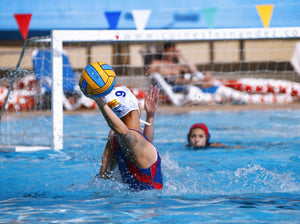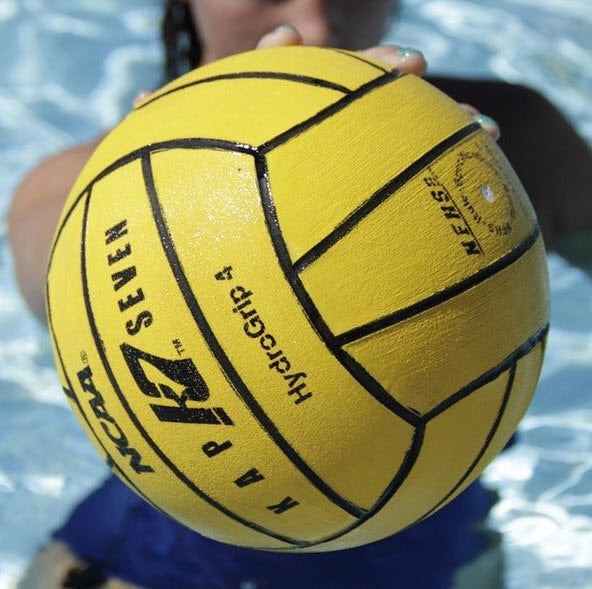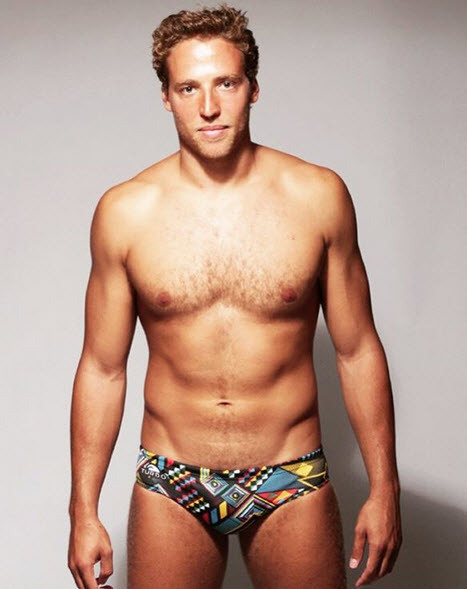Water Polo Drills
In water polo, both skill and technique are vital when dealing with body positioning and the ball itself. In order to accurately execute a particular skill in a game, whether it is a difficult shot or shutting down an offensive player, drills must be repeated consistently to ensure proper execution during a game. Here are some helpful water polo drills and their applicable benefits for an in-game situation:
Water Jumping-Jacks
This drill does not require any equipment — just the pool. The player will swim five meters at a max-effort pace, come to a stop and explode as high out of the water as possible (clapping hands over head), then repeat. The player should execute this high-conditioning workout across the pool and rest as needed.
Purpose: In-game situations always require the defense to cover its opponent as tight as possible, especially when a specific offensive player has possession of the ball. A short, violent explosion, followed by a max-height vertical will improve your ability to quickly drive into your opponent and jump up to block a shot, prevent a pass, or steal the ball. Similarly, this drill can be applied to an offensive drive to a shot, as the offender would also have to explode with a sprint-to-jump in order to open himself for a clear pass-to-shot.
Wrestle & Shoot
This particular drill requires four (or more) players (including a goalie). One player positions himself cross-cage from the other two. Make sure this lone player has the five water polo balls. The other two players position themselves cross-cage from the sole player, one taking the offensive position and the other taking the defensive position. At the start, offensive and defensive players begin wrestling in water for 30 seconds. When that time is up, the whistle sounds and players stop wrestling. Immediately after, sole cross-cage player passes offensive player five pass-to-shots on goal.
Purpose: This drill will condition the athlete to have a high level of accuracy while fatigued. In-game situations rarely feature shots on goal from a passive state; the offensive has to physically earn the opening for a promising shot on goal.
Sprint to Ball: Winner Attacks
This drill best works with three (or more) players, but technically requires two players. After throwing the ball into the middle of the pool, both players position themselves so each is touching their goal post. At the start, both players sprint to the floating ball in the middle of the pool. The first player to the ball assumes the offensive position and the other assumes the defensive position. The offensive player continues to drive through with the ball to the other cage to score while the defensive player tries to catch up and steal the ball. The defensive player is not encouraged to drawl a foul or kick out with this drill, but rather work on “skillfully” trying to steal the ball from the opponent.
 Purpose: Besides the obvious benefit that sprints across the pool will improve conditioning, this drill will work on both the players’ offensive and defensive skills. Dribbling with a defender close behind is a common in-game situation with which players should become comfortable. Offensive players can work on driving with a defender chasing them, taking wet shots, or even drawling fouls/kick outs/5m penalty shots. Defensive skills are also challenged, as the defender is required to catch up to his opponent and steal the ball without causing a foul or penalty.
Purpose: Besides the obvious benefit that sprints across the pool will improve conditioning, this drill will work on both the players’ offensive and defensive skills. Dribbling with a defender close behind is a common in-game situation with which players should become comfortable. Offensive players can work on driving with a defender chasing them, taking wet shots, or even drawling fouls/kick outs/5m penalty shots. Defensive skills are also challenged, as the defender is required to catch up to his opponent and steal the ball without causing a foul or penalty.
Water Polo Individual Medley
No equipment is needed for this drill; treat as you would a normal individual medley. Perform a single lap of the following swim events: Butterfly, head-up backstroke (looking down-field), waist-high bulldog, head-up freestyle.
Purpose: Each “event” holds its own unique value for bettering your water polo skills. The butterfly betters your conditioning; the backstroke betters your ability to travel down-field with “heads-up” knowledge of the ball’s location; maintaining adequate height while bulldogging is important as a defenseman while approaching an offensive player; heads-up freestyle is important for both offensive and defensive players, as it is the foundation for such skills as dribbling and driving, and also allows you to gain knowledge of the ball and other player positions while in-game.
180-Degree Passing
This drill requires three (or more) players. Evenly station three players across the field, from cage-to-cage, so they form a straight line. One outside player passes to the middle player (who is facing him). The middle player then turns 180 degrees and passes (or performs a 180-degree, no-look shot) to the other outside player. That outside player receives the ball and passes it back to the middle player (who is now facing him). The middle player again spins 180 degrees to the alternate outside player and passes to him. Players rotate positions after 3 to 5 minutes.
Purpose: Quick, 180-degree turn-to-passes can be a huge asset when working to move the ball down-field. For instance, if your teammate is on a breakaway and your goalie is being pressed and is unable to make an accurate pass that far down-field, you can act as a cut-of man and intercept the long-range pass for better accuracy or a change of play.
Hot Potato
This drill requires six players (and a goal with a goalie, if possible). Players set up in a standard six-on-five offensive pattern. At the top of a descending 20 second clock, players begin passing the ball amongst each other. Players are prevented from holding onto the ball for more than two seconds, forcing them to pass the ball as soon as it’s passed to them. When 20 seconds are up, the player with the ball is required to shoot the ball at the cage.
Purpose: Drawing a kick-out can be a huge offensive advantage, but only if the offensive team can capitalize on the situation. Fast, accurate passing is crucial for an efficient six-on-five offense. Often staggering the 2m wings with the two players at the 2m posts will yield a better offensive passing position.
Red Light, Green Light
This drill requires either one (or more) player(s) at one end of the pool facing down-field, and a coach at the other end of the player’s position (where the players are facing). On the coach’s command, players are sent swimming to him but are required to stop on his call, which is at random. The coach will then randomly recommence the swim effort toward his position. The coach can also call out specific actions for players to do — things like jumping-jacks, lunges left/right, bulldogs, etc.
Purpose: Water polo games are sporadic and ever-changing. Constant steals, turnovers, shots, and kick-outs make the sport’s non-stop play both physically demanding and unpredictable. As in this particular drill, players must be prepared for anything and always be aware of the referee outside of the pool.
Simulate the Game

These water polo drills are all about recreating common in-game scenarios.They will help prepare players for the pressure that comes with each specific situation. Acquiring a comfort level to the pressures and components surrounding you will allow you to think clearly and make the right decisions while in-game. Think about some of your own in-game weaknesses and ways of recreating the situations that call for the use of those weaknesses. Keep practicing the movements, and eventually your skill and comfort levels will both improve.



